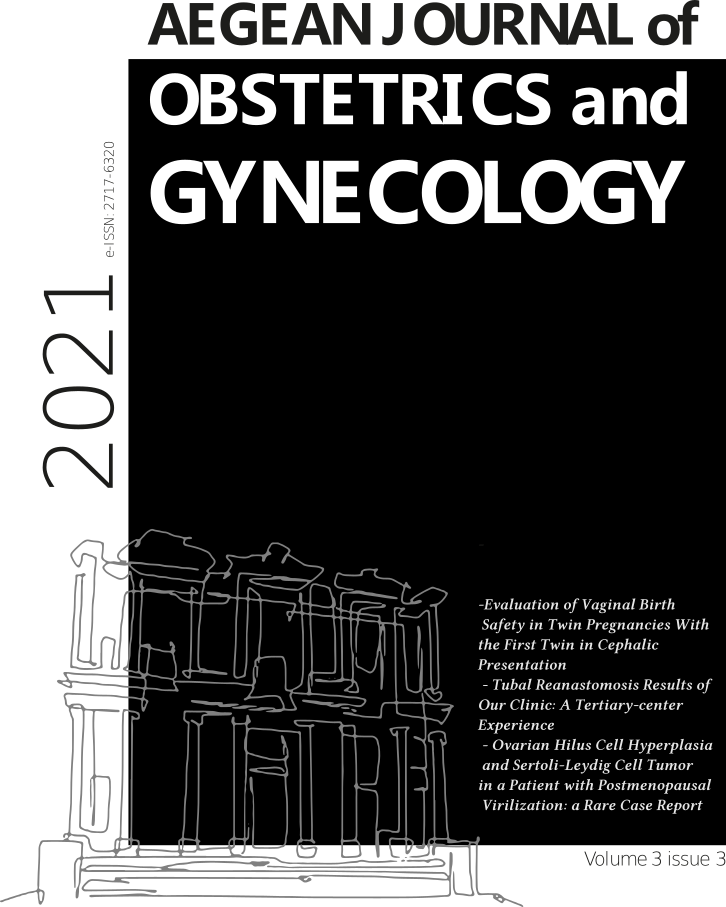Immunolocalization of FOXP3, JAK1 and STAT5 in Preeclamptic, Intrauterine Growth Restricted and Gestational Diabetic Human Placentas
DOI:
https://doi.org/10.46328/aejog.v3i3.101Keywords:
preeclampsia, intrauterin growth restriction, gestational diabetes mellitus, FOXP3, JAK1 and STAT5 receptorsAbstract
Objective: The aim of the study to show the relation of T cells in placental villous fragments with FOXP3,JAK1 and STAT5 receptors in different conditions such as GDM, PE and IUGR placental tissues.
Methods: Specimens of ten(10) diabetic placentas, ten(10) preeclamptic, ten(10) intrauterine growth restricted placentas and ten(10) control placentas were collected by systematic uniform random sampling. Immunohistochemical detections of FOXP3, JAK1 and STAT5 were performed in histological sections for each group’s placental tissue. The H-score value was derived for each specimen by calculating the sum of the percentage of syncytiotrophoblast and syncytial nodes in placenta and intervillus area. They were categorized by intensity of staining, multiplied by its respective score.
Results: FOXP3, JAK1 and STAT5 immunoreactivity comparisons are shown in four groups of placentas. FOXP3 immunoreactions significantly increase in GDM group. JAK1 and STAT5 immunoreactions significantly decrease in PE group. STAT5 immunoreactivity was detected crucially increase in GDM group.
Discussion: The results showed that in different conditions such as PE,GDM and IUGR, T cells in placental villous fragments have relation with FOXP3,JAK1 and STAT5 receptors and that FOXP3 can inactivate the PE and IUGR in the placental tissue. We have also confirmed as other studies that JAK-STAT pathway plays important role in PE,IUGR and GDM placental tissue.
Downloads
Published
Issue
Section
License
Copyright (c) 2021 Volkan Emirdar, Gulcin Ekizceli , Yagmur Dilber , Sevinc Inan , Muzaffer Sanci

This work is licensed under a Creative Commons Attribution-NonCommercial 4.0 International License.
AEJOG is an open-access journal which means that through the internet; freely accessible, readable, downloaded, copied, distributed, printed, scanned, linked to full texts, indexed, transferred to the software as data and used for any legal purpose, without financial, legal and technical obstacles. The only authority on reproduction and distribution and the sole copyright role in this field; has been given to authors therefore they can have control over the integrity of their work, so that they are properly recognized and cited. This is in accordance with the BOAI definition of open access.
The content in Aegean Journal of Obstetrics and Gynecology (AEJOG) is protected by copyright. All copyrights of the submitted articles are transferred to the Aegean Journal of Obstetrics and Gynecology within the national and international regulations at the beginning of the evaluation process. Upon submission of their article, authors are requested to complete an assignment of copyright release form. Authors should acknowledge that they will not submit their manuscript to another journal, publish in any other language, or allow a third party to use the article without the written consent of the Aegean Journal of Obstetrics and Gynecology. When an article is published on AEJOG, it is read and reused for free as soon as it is published under a Creative Commons Attribution-NonCommercial 4.0 (CC BY NC 4.0) license. In case the article is rejected, all copyrights are given back to the authors.
The content of the article and all legal proceedings against the journal, if any, are the responsibility of the author. In addition, all financial and legal liability for the copyright of the presented tables, figures and other visual materials protected by law belongs to the authors. It is the responsibility of the corresponding author to report authors scientific contributions and responsibilities regarding the article. In case of any conflict of interest, it is the responsibility of the authors to indicate the conflict of interest in the Disclosure part of the article. Author names will be published as they are listed on the submitted Title page.




